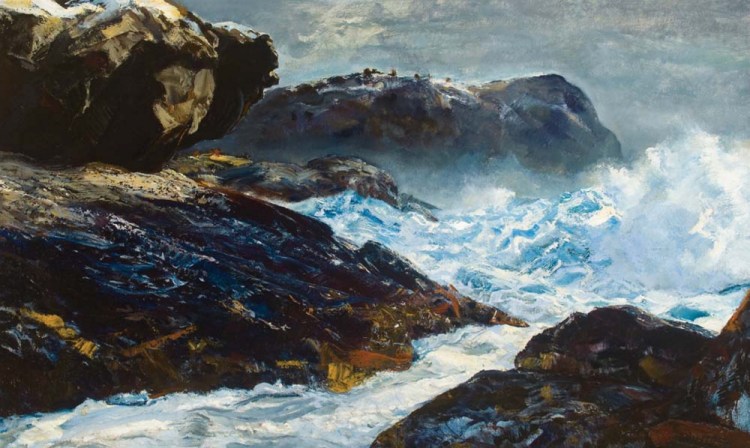In the summer, artists crawl all over Maine’s Monhegan Island. They’re on the pathways and roads that lead to and from the landing, in the woods and on the rocks. Easels are everywhere.
In the winter, the artists leave. That’s generally how it’s been on Monhegan since painters began going there in the mid-1800s. This summer, the Monhegan Museum of Art & History tells the story of an appropriately named artist who stayed year-round. “Reckoning with Nature: Andrew Winter at Monhegan Island” shows the dramatic nature of the island in all seasons, including the winter when snow and ice cover the island and keep the tourists, and most of the painters, away.
Andrew Winter was an exception, said museum director Edward L. Deci.
“If you go back through the years, the artists on Monhegan overwhelmingly have been people who were here for the summer. There’s just a small number who lived year-round,” Deci said. “It really was unusual, and the thing that goes along with that with respect to Andrew Winter, he was very much into the heavy, rough seas and the ice and snow. As people who knew him said, he was out in any weather. It didn’t matter what it was, he was out there painting, and an awful lot of his work is of winter scenes, with lots of ice and snow and very rough waters.”
Winter lived on Monhegan year-round from 1940 until his death in 1958. He began coming to Monhegan seasonally in the early 1930s. A native of Estonia, Winter sailed around the world before arriving in the United States and becoming a U.S. citizen. He spent his childhood on the Baltic Sea and worked as a seaman beginning when he was about 20 years old. He loved the ocean and was drawn to its drama, and saved money from his time at sea to pay for art school, Deci said.

“Hauling in the Traps” by Andrew Winter, circa 1940s, oil on canvas.
“While he was on these ships, he was paying a lot of attention to the ocean and the relationship of boats to the ocean. The whole experience would later influence the painting he did on Monhegan,” Deci said.
He came to the United States in the 1920s and settled in New York, where he enrolled in the School of the National Academy of Design and established himself in the art world. In New York, he became acquainted with Jay Hall Connaway, an artist who had been to Monhegan and encouraged Winter to go north to see for himself. “He was telling Winter, ‘There is this place you’ve got to go. It’s unbelievable. You’ll be blown away.’ ”

Gulls at Monhegan, 1936, oil on canvas, 22 x 28 inches
Winter followed the advice, and within a decade of making seasonal visits, he and his wife decided to leave New York and live on Monhegan full time. Doing so opened up new subjects for his paintings, Deci said.
Comfortable and experienced on the water, Winter rowed his small boat into heavy seas to observe lobstermen, who worked through the cold-weather season. He was interested in capturing their perspective and needed to understand their point of view, so he put himself in the best position to watch and learn, which was between the swells and alongside the fishermen.
“A lot of his paintings involved winter lobstering, because he was right out there with them in his own little skiff watching them do it and taking notes to turn his thoughts into major paintings,” Deci said.
“Reckoning with Nature” portrays Monhegan in all seasons, but the overall tone presents an image of Monhegan that is cold, gray and rugged.
“There are paintings of the headlands covered in ice that you look at and you just shiver,” Deci said.
Staff Writer Bob Keyes can be contacted at 791-6457 or at:
bkeyes@pressherald.com
Twitter: pphbkeyes
Send questions/comments to the editors.




Success. Please wait for the page to reload. If the page does not reload within 5 seconds, please refresh the page.
Enter your email and password to access comments.
Hi, to comment on stories you must . This profile is in addition to your subscription and website login.
Already have a commenting profile? .
Invalid username/password.
Please check your email to confirm and complete your registration.
Only subscribers are eligible to post comments. Please subscribe or login first for digital access. Here’s why.
Use the form below to reset your password. When you've submitted your account email, we will send an email with a reset code.